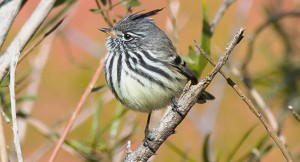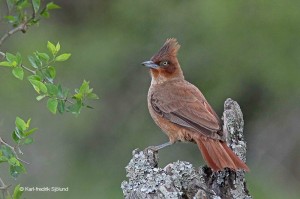Week 14 – 09 October 2016:
When a Tree is Not Just a Tree
Birds have an uncanny ability to fill our lives with joy by simply being there. In the depths of a Australian summer, under the cruel, baking sun of the outback, it takes just a small waterhole to attract Zebra Finches. On a dimly-lit morning in the coldest part of a Canadian prairie winter, a bird feeder stocked with seeds will attract House Sparrows. Wherever you are in the world, birds are there to be seen.
But we need to take care. The mere presence of birds does not guarantee that all is well with the world. In our near-limitless capacity to transform the landscape, we may be making subtle changes. It sometimes takes a keen eye to notice that change.
Fabrico Cid and Enrique Caviedes-Vidal of the Universidad Nacional de San Luis in Argentina recently published a paper concerning human-created changes to the birdlife of a region around a reservoir. The Embalse La Florida was constructed between 1945 and 1953, and serves as the main source of drinking water to the cities of San Luis (170,000 residents) and Villa Mercedes (111,000 residents). The reservoir has an area of more than 650 ha (1,600 acres) and a circumference of 36 km (22 miles), and provides recreational opportunities in the form of swimming, fishing, kayaking and windsurfing. That all sounds pretty good, right?
A portion of the land around the reservoir is a combination of native woodlands, Acacia shrubs and grasslands, but the remainder has been modified as small-scale tree plantations in support of campsites and a settlement. The plantations are dominated by trees not native to Argentina such as pine and eucalyptus.
Cid and Caviedes-Vidal surveyed the bird populations of the natural habitat and tree plantations in both the breeding and non-breeding seasons. They documented almost 3000 birds of 75 species. The smallest was the 5 g (0.2 ounce) Yellow-billed Tit-tyrant, and the largest was the 1.9 kg (4.2 pounds) Black Vulture. Spot-winged Pigeons were far more abundant than any other species.
In both the breeding and non-breeding seasons, bird abundance was higher in tree plantations than among native plants; species richness was similar between the two habitat types. Even though the distances between sites was short, most bird species were seen in one habitat type or the other, but not both. Cattle Tyrants, Monk Parakeets and Brown Cacholotes were only seen in the plantations, whereas Pale-breasted Spinetails and Southern Bearded-tyrannulets were seen only in the natural habitats. Plantations favored large-bodied generalist feeders; native vegetation favored smaller-bodied birds that feed within the foliage of the plants.
Changing the landscape changes the composition of the bird population within it. Although no birds of special conservation concern were recorded by Cid and Caviedes, the authors pointed out that the area covered by tree plantations could grow substantially in the near future. Loss of natural habitat is likely to have consequences for birds that rely on those conditions. With an expanding human population, it may become necessary to set aside patches of native vegetation in the region. Biological diversity is a matter of variation as well as abundance.
Cid, F. D. and E. Caviedes-Vidal. 2014. Differences in bird assemblages between native natural habitats and small-scale tree plantations in the semiarid midwest of Argentina. Wilson J. Ornithol. 126:673-685.
Photo credits: Yellow-billed Tit-tyrant © Jorge Martín Spinuzza (www.avespampa.com.ar & neotropical.birds.cornell.edu); Brown Cacholote © Karl-Fredrik Sjolund - buenosairesbirding.com/birds



